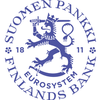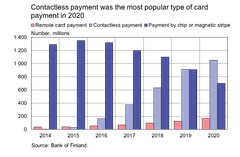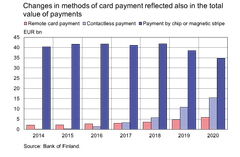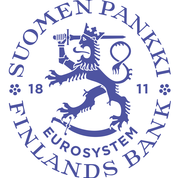The exceptional conditions were reflected in card payments in 2020
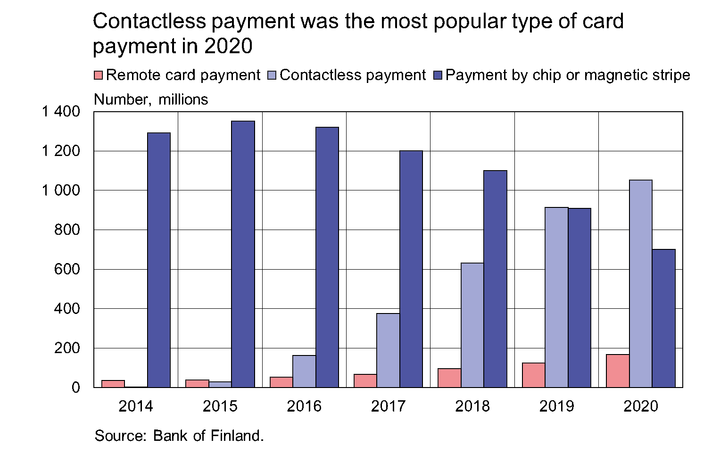
Card payments have increased in popularity for already a long period of time, whereas the use of cash has decreased. During the coronavirus pandemic, payment by card has been favoured also due to reasons of hygiene. The ways of using payment cards have also changed. Contactless payment increased in 2020, and it accounted for 55% of the total volume of card payments. Five years earlier, only 2% of card payments were made using the contactless payment function, so transition to this type of payment has been rapid. The upper limit of contactless payments was raised to EUR 50 in April 2019, the impact of which is reflected in full in the figures for 2020. Within a period of twelve months, the average value of contactless payments increased from EUR 11.91 to EUR 14.72. The total value of these payments rose to EUR 15.5 bn in 2020, which is 42% higher than the year earlier.
Remote card payment[1] too, became more common during the coronavirus pandemic. A total of 168 million remote payments were made during the pandemic, which is 36% more than in the previous year. Their total value grew by 23% and was EUR 5.8 bn in 2020.
In 2020, less card payments were made using a chip or a magnetic stripe than in the previous year. The number of these card payments decreased by 23% on 2019. Sums that are higher than the upper limit of contactless payments always require that the card is inserted in the card reader, and therefore, of card payments with the various payment functions, the total value of those with a chip or magnetic stripe has remained the highest. The value of card payments initiated with a chip or a magnetic stripe was EUR 34.7 bn, which is 62% of the total value of all card payments in 2020.
The exceptional conditions were reflected also in card payments that went abroad. The value of card payments with Finnish cards to Finland increased, whereas the value of card payments that went abroad decreased by 18% in 2020. The fading of travelling was reflected, in particular, in card payments made abroad with a chip or magnetic stripe, the value of which declined almost 40%. In contrast, the value of remote card payments that went abroad grew, fuelled by brisk activity in e-commerce.
For a more detailed analysis of the impact of the coronavirus pandemic on payment, see the article on the Bank of Finland Bulletin website (in Finnish):
https://www.eurojatalous.fi/fi/2021/2/koronapandemia-muuttaa-maksutapoja-pysyvasti/
New in payment statistics
The figures discussed in this news release have been published in table and chart format in the new payment statistics dashboard. Initially, the dashboard will include, in addition to the figures presented in this news release, also data on credit transfers and payments with various types of cards. The contents of the dashboard will be extended later to correspond with the earlier table-format release. The table will no longer be updated.
Subscribe to our payment statistics newsletter (Payments and cash) and get an electronic alert as soon as new releases become available!
For further information, please contact
Olli Tuomikoski, tel. +358 9 183 2146, email: olli.tuomikoski(at)bof.fi,
Pauliina Turunen, tel. +358 9 183 2436, email: pauliina.turunen(at)bof.fi
[1] Remote card payments include card payments other than those at physical points of sale, i.e. card payments related to e-commerce or within mobile applications.
Images
Links
About Suomen Pankki
The Bank of Finland is the national monetary authority and central bank of Finland. At the same time, it is also a part of the Eurosystem, which is responsible for monetary policy and other central bank tasks in the euro area and administers use of the world’s second largest currency – the euro.
Subscribe to releases from Suomen Pankki
Subscribe to all the latest releases from Suomen Pankki by registering your e-mail address below. You can unsubscribe at any time.
Latest releases from Suomen Pankki
Inlåningen från hushållen var den största genom tiderna i november 20257.1.2026 10:00:00 EET | Pressmeddelande
Inlåningen från hushållen har ökat 2025 samtidigt som inlåningsräntorna har sjunkit. Inlåningen har ökat i alla inlåningsformer. Dessutom ingick finländska företag i november rikligt med nya avtal om tidsbunden inlåning.
Kotitalouksien talletuskanta oli kaikkien aikojen suurin marraskuussa 20257.1.2026 10:00:00 EET | Tiedote
Kotitaloudet ovat kasvattaneet talletuksiaan vuonna 2025 samaan aikaan kun talletusten korot ovat laskeneet. Talletukset ovat kasvaneet kaikissa talletusmuodoissa. Lisäksi suomalaiset yritykset solmivat marraskuussa runsaasti uusia määräaikaistalletussopimuksia.
Households' deposit stock at all-time high in November 20257.1.2026 10:00:00 EET | Press release
Households have increased their deposits in 2025 while interest rates on deposits have declined. Deposits have grown in all deposit categories. In addition, Finnish corporations concluded a high volume of new agreements on deposits with agreed maturity in November.
Referensränta och dröjsmålsräntor enligt räntelagen för tiden 1.1–30.6.202622.12.2025 13:30:00 EET | Pressmeddelande
Referensräntan enligt 12 § i räntelagen (633/1982) är 2,5 % för tiden 1.1–30.6.2026. Dröjsmålsräntan för denna period är 9,5 % per år (referensräntan med tillägg för sju procentenheter enligt 4 § i räntelagen). Den dröjsmålsränta som tillämpas i kommersiella avtal är 10,5 % per år (referensräntan med tillägg för åtta procentenheter enligt 4 a § i räntelagen).
Korkolain mukainen viitekorko ja viivästyskorot 1.1.–30.6.202622.12.2025 13:30:00 EET | Tiedote
Korkolain (633/1982) 12 §:n mukainen viitekorko ajanjaksona 1.1.–30.6.2026 on 2,5 %. Viivästyskorko tänä ajanjaksona on 9,5 % vuodessa (viitekorko lisättynä korkolain 4 §:n mukaisella 7 prosenttiyksikön lisäkorolla). Kaupallisiin sopimuksiin sovellettavaksi tarkoitettu viivästyskorko on 10,5 % vuodessa (viitekorko lisättynä korkolain 4 a §:n mukaisella 8 prosenttiyksikön lisäkorolla).
In our pressroom you can read all our latest releases, find our press contacts, images, documents and other relevant information about us.
Visit our pressroom